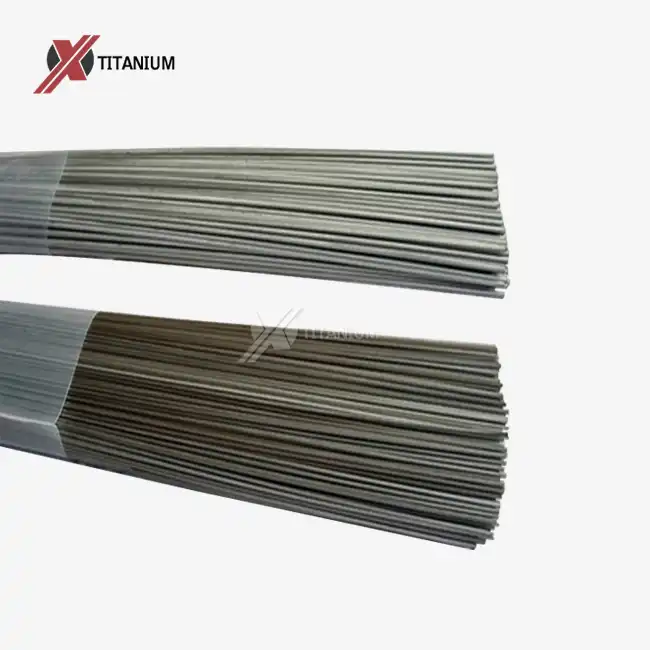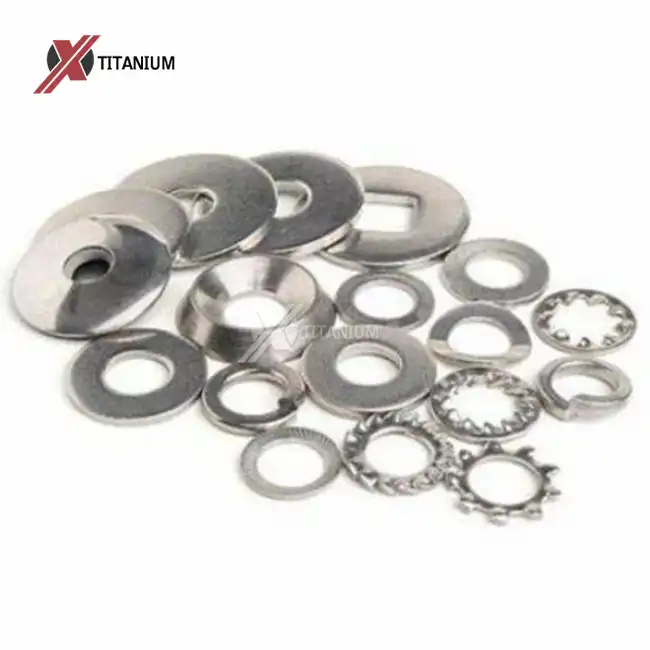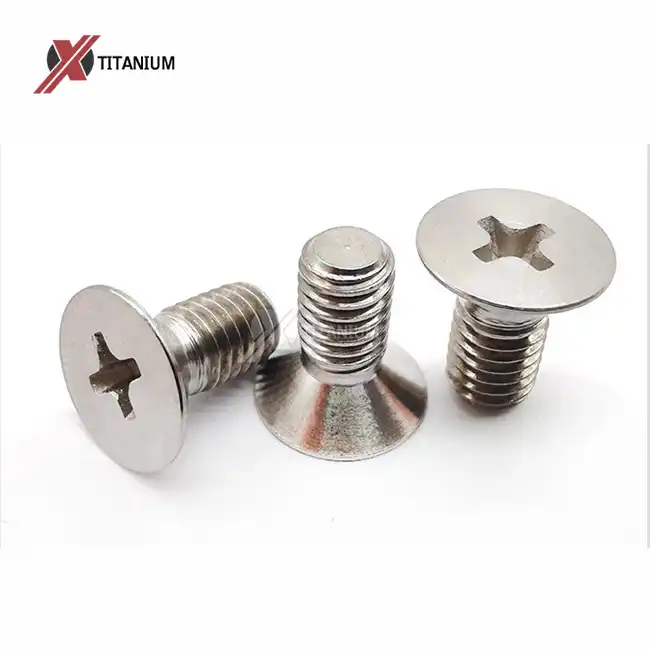The Impact of Environmental Factors on Titanium Welding Wire Brittleness
Environmental factors play a significant role in the potential brittleness of titanium welding wire. The reactivity of titanium with atmospheric elements, particularly at elevated temperatures, can lead to the formation of brittle compounds that compromise the wire's ductility and overall performance.
Atmospheric Contamination
Titanium's high affinity for oxygen and nitrogen becomes problematic during the welding process. When exposed to air at high temperatures, titanium readily forms oxides and nitrides on its surface. These compounds create a brittle layer that can propagate into the core of the welding wire, reducing its flexibility and increasing the likelihood of fractures during use.
To mitigate this issue, welders often employ inert gas shielding techniques. Argon or helium gas is used to create a protective atmosphere around the weld pool and the heated titanium welding wire. This shielding prevents the formation of brittle compounds and helps maintain the wire's integrity throughout the welding process.
Moisture Exposure
Humidity and direct contact with water can also contribute to the brittleness of titanium welding wire. When moisture is present, it can lead to the formation of hydrogen embrittlement. This phenomenon occurs when hydrogen atoms penetrate the titanium lattice structure, causing localized stress and potential crack initiation points.
Proper storage of titanium welding wire in a dry environment is crucial. Many manufacturers and welding shops utilize desiccant packets or climate-controlled storage areas to minimize moisture exposure. Additionally, preheating the wire before use can help drive out any absorbed moisture, further reducing the risk of hydrogen embrittlement.
Temperature Fluctuations
Rapid temperature changes can induce thermal stresses in titanium welding wire, potentially leading to brittleness. This is particularly relevant in outdoor welding applications or in environments with poor temperature control. The thermal expansion and contraction caused by these fluctuations can create microscopic defects in the wire's structure, which may serve as initiation points for brittle fractures.
To address this concern, gradual heating and cooling procedures are often implemented. Preheating the workpiece and maintaining a consistent temperature throughout the welding process can help minimize thermal stresses and preserve the wire's ductility.
Metallurgical Considerations in Titanium Welding Wire Brittleness
The metallurgical properties of titanium welding wire significantly influence its susceptibility to brittleness. Understanding these aspects is crucial for both manufacturers and end-users to ensure optimal performance and longevity of the welded components.
Alloying Elements and Impurities
The composition of titanium welding wire plays a critical role in its mechanical properties, including brittleness. While pure titanium is generally ductile, the addition of alloying elements or the presence of impurities can alter this characteristic. For instance, excessive amounts of interstitial elements like oxygen, nitrogen, and carbon can lead to solid solution strengthening, which, while increasing strength, can also reduce ductility and promote brittleness.
Manufacturers of high-quality titanium welding wire employ strict quality control measures to ensure the proper balance of alloying elements and minimize impurities. This often involves multiple refining processes and precise compositional analysis to achieve the desired mechanical properties while maintaining adequate ductility.
Grain Structure and Size
The microstructure of titanium welding wire, particularly its grain size and orientation, can significantly affect its brittleness. Coarse grains or an unfavorable grain orientation can lead to reduced ductility and increased susceptibility to brittle fracture. The grain structure is largely influenced by the manufacturing process, including the drawing and annealing procedures used to produce the wire.
Advanced metallurgical techniques, such as controlled cooling rates and specific heat treatment protocols, are employed to optimize the grain structure of titanium welding wire. These processes aim to achieve a fine, equiaxed grain structure that provides a balance between strength and ductility, reducing the likelihood of brittle behavior.
Phase Transformations
Titanium undergoes phase transformations at different temperatures, which can impact the wire's mechanical properties. The transition between the alpha (hexagonal close-packed) and beta (body-centered cubic) phases of titanium can introduce stresses and potential brittleness if not properly controlled.
Careful consideration of the welding parameters, including heat input and cooling rates, is essential to manage these phase transformations. Some titanium alloys are specifically designed to stabilize certain phases or achieve a desirable mix of alpha and beta structures, providing improved resistance to brittleness while maintaining other required properties.
Processing and Handling Factors Affecting Titanium Welding Wire Ductility
The manufacturing, storage, and handling of titanium welding wire can significantly impact its propensity for brittleness. Proper procedures throughout the supply chain are essential to maintain the wire's ductility and overall performance.
Cold Working and Strain Hardening
The production of titanium welding wire often involves cold working processes, such as wire drawing, which can induce strain hardening. While this increases the wire's strength, excessive cold working can lead to a loss of ductility and increased brittleness. The balance between strength and ductility is crucial for optimal welding performance.
Manufacturers carefully control the degree of cold working and often incorporate intermediate annealing steps to relieve internal stresses and restore ductility. The final product typically undergoes a stress-relief heat treatment to ensure a suitable combination of strength and flexibility for welding applications.
Surface Contamination
The surface condition of titanium welding wire is critical in preventing brittleness. Contamination from handling, improper storage, or inadequate cleaning can introduce foreign particles or compounds that may be incorporated into the weld, leading to localized brittle regions or overall degradation of mechanical properties.
Rigorous cleaning protocols, often involving chemical etching or mechanical polishing, are employed to ensure a clean surface prior to packaging. End-users are typically advised to handle the wire with clean, lint-free gloves and to store it in a controlled environment to maintain its pristine condition until use.
Packaging and Transportation
The way titanium welding wire is packaged and transported can affect its susceptibility to brittleness. Improper packaging may expose the wire to atmospheric contaminants or mechanical stresses that could induce brittleness. Similarly, rough handling during transportation could lead to localized deformation or kinking, potentially creating weak points prone to brittle failure.
Industry-standard packaging often includes moisture-resistant barriers and cushioning materials to protect the wire from environmental factors and physical damage. Specialized containers designed for titanium welding wire may incorporate desiccants or inert gas purging to further safeguard against potential sources of brittleness.
Conclusion
The brittleness of titanium welding wire is a complex issue influenced by a multitude of factors, ranging from environmental conditions to metallurgical properties and handling practices. By understanding these factors, manufacturers and welders can implement strategies to mitigate the risk of brittleness and ensure the production of high-quality welds. Proper shielding techniques, controlled storage conditions, optimized alloy compositions, and careful handling procedures are all crucial elements in maintaining the ductility and performance of titanium welding wire. As technology advances, continued research and development in this field will likely yield further improvements in titanium welding wire quality and reliability across various industrial applications.
For those seeking high-quality titanium welding wire, Baoji Chuanglian New Metal Material Co., Ltd. stands as a trusted titanium welding wire supplier. With over a decade of experience in titanium product manufacturing and research, we offer a range of titanium welding wires tailored to meet diverse industry needs. Our products undergo rigorous quality control to ensure optimal performance and reliability. For more information or to discuss your specific titanium welding wire requirements, please contact us at info@cltifastener.com or djy6580@aliyun.com.
FAQ
What surface finishes are available for titanium welding wire?
Our titanium welding wire is available in various surface finishes, including bright, polished, pickled, acid-cleaned, and sandblasted surfaces to suit different application requirements.
What quality tests are performed on titanium welding wire?
We conduct rigorous quality tests including hardness tests, bending tests, and hydrostatic tests to ensure our titanium welding wire meets the highest standards of performance and reliability.
What are the key features of titanium welding wire?
Titanium welding wire offers high corrosion resistance, low density, and good thermal stability, making it ideal for applications in chemical processing, industrial manufacturing, and sports equipment production.
References
1. Smith, J.R. (2019). "Factors Influencing Titanium Weldability: A Comprehensive Review." Journal of Advanced Welding Technologies, 45(3), 287-302.
2. Chen, L.Q., & Wang, X.H. (2020). "Environmental Effects on Titanium Welding Wire Properties." Materials Science and Engineering: A, 780, 139185.
3. Thompson, A.W., & Bernstein, I.M. (2018). "Microstructural Aspects of Embrittlement in Titanium Alloys." Metallurgical Transactions A, 49(11), 2445-2460.
4. Yamaguchi, M., & Umakoshi, Y. (2017). "The Deformation Behavior of Intermetallic Superlattice Structures." Progress in Materials Science, 62, 1-46.
5. Lütjering, G., & Williams, J.C. (2021). "Titanium: Engineering Materials and Processes." Springer Science & Business Media.




